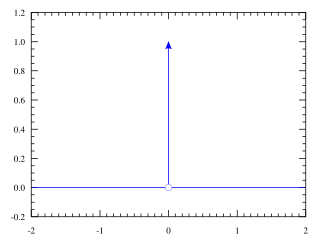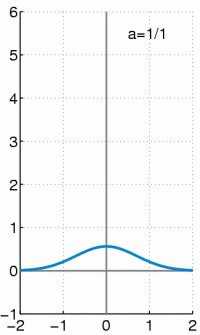
A | B | C | D | E | F | G | H | CH | I | J | K | L | M | N | O | P | Q | R | S | T | U | V | W | X | Y | Z | 0 | 1 | 2 | 3 | 4 | 5 | 6 | 7 | 8 | 9


| Differential equations |
|---|
| Scope |
| Classification |
| Solution |
| People |
In mathematical analysis, the Dirac delta function (or δ distribution), also known as the unit impulse,[1] is a generalized function on the real numbers, whose value is zero everywhere except at zero, and whose integral over the entire real line is equal to one.[2][3][4] Since there is no function having this property, modelling the delta "function" rigorously involves the use of limits or, as is common in mathematics, measure theory and the theory of distributions.
The delta function was introduced by physicist Paul Dirac, and has since been applied routinely in physics and engineering to model point masses and instantaneous impulses. It is called the delta function because it is a continuous analogue of the Kronecker delta function, which is usually defined on a discrete domain and takes values 0 and 1. The mathematical rigor of the delta function was disputed until Laurent Schwartz developed the theory of distributions, where it is defined as a linear form acting on functions.
Motivation and overview
The graph of the Dirac delta is usually thought of as following the whole x-axis and the positive y-axis.[5]: 174 The Dirac delta is used to model a tall narrow spike function (an impulse), and other similar abstractions such as a point charge, point mass or electron point. For example, to calculate the dynamics of a billiard ball being struck, one can approximate the force of the impact by a Dirac delta. In doing so, one not only simplifies the equations, but one also is able to calculate the motion of the ball, by only considering the total impulse of the collision, without a detailed model of all of the elastic energy transfer at subatomic levels (for instance).
To be specific, suppose that a billiard ball is at rest. At time it is struck by another ball, imparting it with a momentum P, with units kg⋅m⋅s−1. The exchange of momentum is not actually instantaneous, being mediated by elastic processes at the molecular and subatomic level, but for practical purposes it is convenient to consider that energy transfer as effectively instantaneous. The force therefore is P δ(t); the units of δ(t) are s−1.
To model this situation more rigorously, suppose that the force instead is uniformly distributed over a small time interval . That is,
Then the momentum at any time t is found by integration:
Antropológia
Aplikované vedy
Bibliometria
Dejiny vedy
Encyklopédie
Filozofia vedy
Forenzné vedy
Humanitné vedy
Knižničná veda
Kryogenika
Kryptológia
Kulturológia
Literárna veda
Medzidisciplinárne oblasti
Metódy kvantitatívnej analýzy
Metavedy
Metodika
Text je dostupný za podmienok Creative
Commons Attribution/Share-Alike License 3.0 Unported; prípadne za ďalších
podmienok.
Podrobnejšie informácie nájdete na stránke Podmienky
použitia.
www.astronomia.sk | www.biologia.sk | www.botanika.sk | www.dejiny.sk | www.economy.sk | www.elektrotechnika.sk | www.estetika.sk | www.farmakologia.sk | www.filozofia.sk | Fyzika | www.futurologia.sk | www.genetika.sk | www.chemia.sk | www.lingvistika.sk | www.politologia.sk | www.psychologia.sk | www.sexuologia.sk | www.sociologia.sk | www.veda.sk I www.zoologia.sk





